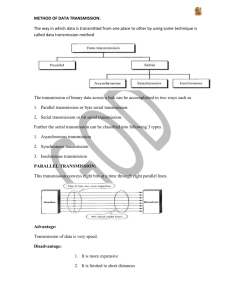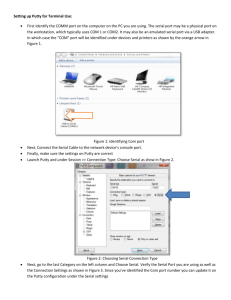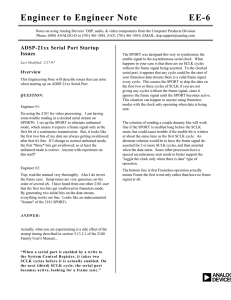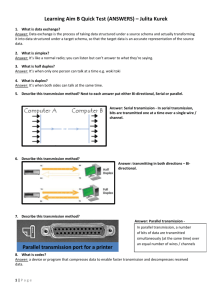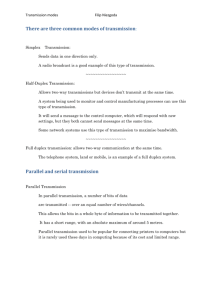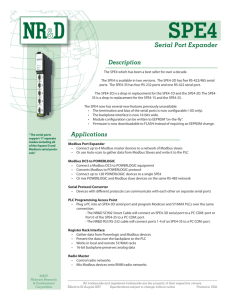Serial port
advertisement
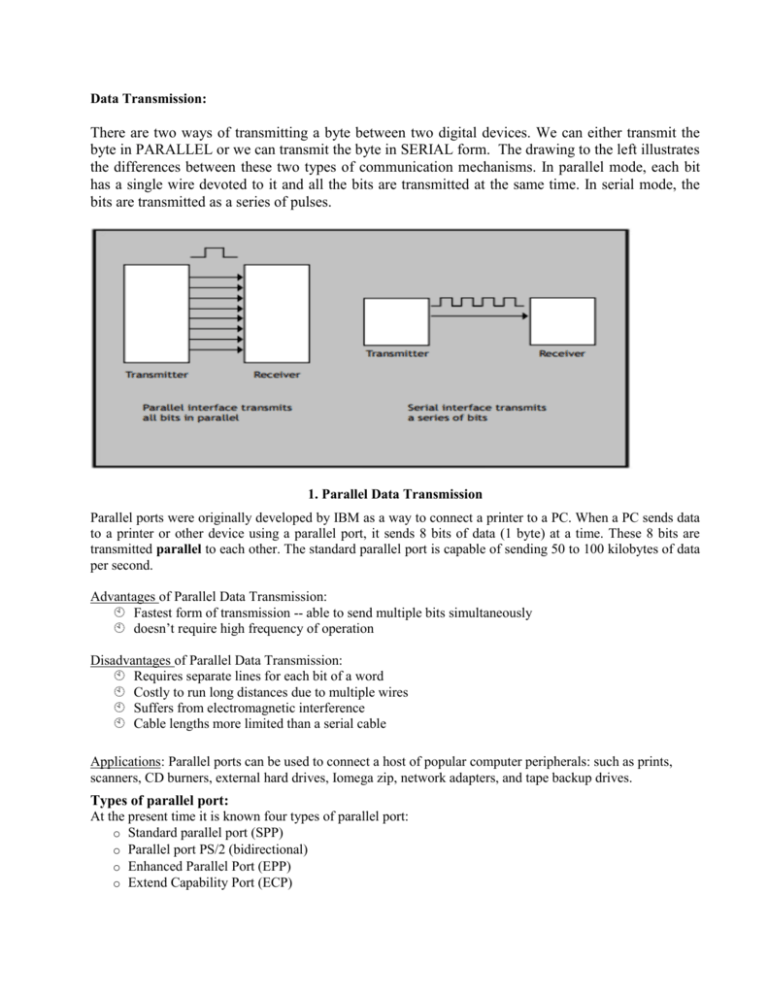
Data Transmission: There are two ways of transmitting a byte between two digital devices. We can either transmit the byte in PARALLEL or we can transmit the byte in SERIAL form. The drawing to the left illustrates the differences between these two types of communication mechanisms. In parallel mode, each bit has a single wire devoted to it and all the bits are transmitted at the same time. In serial mode, the bits are transmitted as a series of pulses. 1. Parallel Data Transmission Parallel ports were originally developed by IBM as a way to connect a printer to a PC. When a PC sends data to a printer or other device using a parallel port, it sends 8 bits of data (1 byte) at a time. These 8 bits are transmitted parallel to each other. The standard parallel port is capable of sending 50 to 100 kilobytes of data per second. Advantages of Parallel Data Transmission: Fastest form of transmission -- able to send multiple bits simultaneously doesn’t require high frequency of operation Disadvantages of Parallel Data Transmission: Requires separate lines for each bit of a word Costly to run long distances due to multiple wires Suffers from electromagnetic interference Cable lengths more limited than a serial cable Applications: Parallel ports can be used to connect a host of popular computer peripherals: such as prints, scanners, CD burners, external hard drives, Iomega zip, network adapters, and tape backup drives. Types of parallel port: At the present time it is known four types of parallel port: o Standard parallel port (SPP) o Parallel port PS/2 (bidirectional) o Enhanced Parallel Port (EPP) o Extend Capability Port (ECP) Standard parallel port (SPP) DB25 port: 2. Serial Data Transmission: 1. Synchronous Data Transmission: Data is transmitted one bit at a time, using a clock to maintain integrity between words. Advantages: � Only one (half duplex) or two (full duplex) wires are required to send/receive data. � Low cost due to low number of wires. Disadvantages: � Lower speeds than parallel transmissions. � Difficult to maintain data integrity due to problems with synchronizing clocks. 2. Asynchronous Data Transmission: Data is transmitted on bit at a time using start bits and strop bits to maintain integrity between words. Disadvantages: � Lower speeds than parallel transmissions. Key words for SCI Baud Rate: The measure of the number of signal elements transmitted or received per second. Baud rates and data bit rates (bps-bit per second) are not equal in asynchronous transmission due to the start and stop bits. Start Bit: The bit preceding every word that signals the receiver a data word is coming. In some microcontroller (e.g., HC11) the start bit is logic low (0), while in others the start bit is logic high (1). Parity Bit: A bit sometimes added to the end of the data word. There are three possible settings for the parity: none, even, and odd. The setting represents the sum of the 1’s transmitted. Stop Bit: The bit or bits following every word that signals the end of a data word. In some microcontroller (e.g., HC11) the stop bit is logic high (1), while in others the start bit is logic low (0). Half Duplex: Two-way serial communication using only one line. With half duplex, the device can not transmit and received at the same time. Full Duplex: Two-way serial communication using two lines. With full duplex, data can be simultaneously transmitted and received. Applications of SCI � The SCI can be used to transmit/receive data through a modem. � The SCI can be used to transmit/receive data with any device that uses RS-232-C protocol. Serial port An Asynchronous port on the computer used to connect a serial device to the computer and capable of transmitting one bit at a time. Serial ports are typically identified on IBM compatible computers as COM (communications) ports. For example, a mouse might be connected to COM1 and a modem to COM2. With the introduction of USB, FireWire, and other faster solutions serial ports are rarely used when compared to how often they've been used in the past. In the picture to the right is a close up of a DB9 serial port on the back of a computer. What is the serial port used for? Below is a listing of various hardware components that can be purchased and used with your serial port. Mouse, Modem , Network, Printer .

